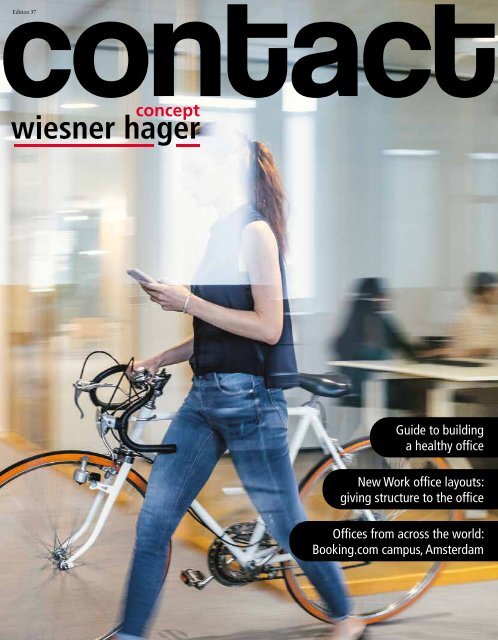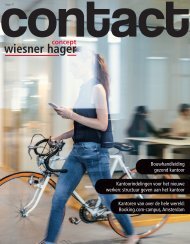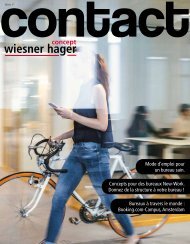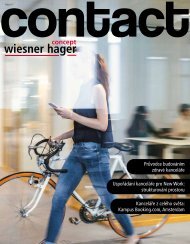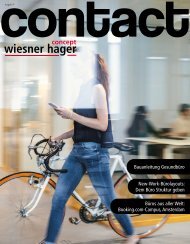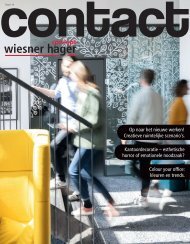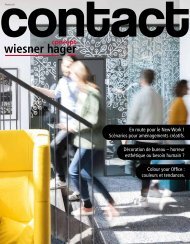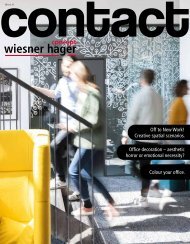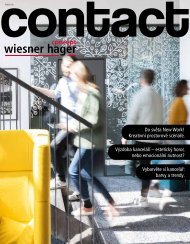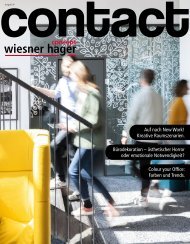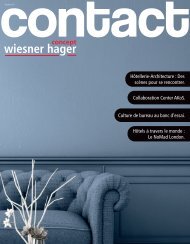contact_magazine_#37_EN
Is sitting the new smoking? “A day in the office without moving is the same on a health basis as smoking a pack of cigarettes!” – US physician and oncologist David B. Agus is being deliberately provocative with this statement, of course, in an effort to focus attention on the important topic of prevention. Our guest author, Wojciech Czaja, has expanded on this, addressing healthy nutrition too, in the cover story. The result is a guide to building a healthy office.
Is sitting the new smoking?
“A day in the office without moving is the same on a health basis as smoking a pack of cigarettes!” – US physician and oncologist David B. Agus is being deliberately provocative with this statement, of course, in an effort to focus attention on the important topic of prevention. Our guest author, Wojciech Czaja, has expanded on this, addressing healthy nutrition too, in the cover story. The result is a guide to building a healthy office.
You also want an ePaper? Increase the reach of your titles
YUMPU automatically turns print PDFs into web optimized ePapers that Google loves.
Edition 37<br />
Guide to building<br />
a healthy office<br />
New Work office layouts:<br />
giving structure to the office<br />
Offices from across the world:<br />
Booking.com campus, Amsterdam
Is sitting the new smoking?<br />
“A day in the office without moving is the same on a health basis as<br />
smoking a pack of cigarettes!” – US physician and oncologist David B.<br />
Agus is being deliberately provocative with this statement, of course, in<br />
an effort to focus attention on the important topic of prevention. Our<br />
guest author, Wojciech Czaja, has expanded on this, addressing healthy<br />
nutrition too, in the cover story. The result is a guide to building a<br />
healthy office.<br />
We ask ourselves a highly topical question: how can we create an optimal<br />
working environment in challenging times? The answer is simple:<br />
by providing structures! The implementation of these ideas can be<br />
complex but entirely feasible, as the story on page 8 shows.<br />
Then we call for attention to a commonly underestimated topic: room<br />
acoustics. There are solutions available from Tante Lotte Design that<br />
promise even a dual benefit!<br />
After that, we accompany Pac-Man to the Munich-based foobar Agency<br />
and make a detour to the new Booking.com campus in Amsterdam. In<br />
Munich, we discover a real boost to creativity and productivity, while in<br />
Amsterdam we see a prime example of the implementation of measures<br />
designed to promote health.<br />
On top of this, a remote junkie meets a desk potato. And finally, a<br />
motivational office chair concept is bound to bring a smile to your face.<br />
Enjoy reading!<br />
Guide to building a healthy office ..........................................04<br />
Give structure to your office! .................................................08<br />
Listen up – now we’re talking acoustics ................................10<br />
Reference story: foobar Agency ..............................................12<br />
Trendwatching: useful ideas for everyday office life ...............15<br />
Remote junkie meets desk potato ..........................................16<br />
Offices from across the world: Booking.com, Amsterdam ......18<br />
What’s on your desk, Max Thinius? ........................................21<br />
Office life: let’s be friends!. ....................................................22<br />
Balanced nutrition in everyday office life ...............................23<br />
Ergonomics with shared desks and coworking ......................24<br />
Showroom: motiv office chair ................................................26<br />
Laura and Markus Wiesner<br />
Publisher: Wiesner-Hager Möbel GmbH, Linzer Strasse 22, A-4950 Altheim, T +43/(0)7723/460-0, altheim@wiesner-hager.com, www.wiesner-hager.com,<br />
thinknewwork.com; concept/editor: Wiesner-Hager, mintmind Communication GmbH; layout: mintmind Communication GmbH,<br />
guest author: Wojciech Czaja; typing and printing errors reserved; 11/2023.<br />
<strong>contact</strong> 3
Office Concepts<br />
Guide to building<br />
a healthy office.<br />
In tangible terms, important homework has been done in recent years by organisations,<br />
the planning sector and the office furniture industry – and they have<br />
created a lot of healthy offices. Now it’s all about tightening the last still remaining<br />
screws in relation to soft, intangible factors. This also includes healthy nutrition.<br />
He recommends swallowing aspirin to prevent<br />
cancer, describes high heels as a risk for inflammation<br />
and even made a very drastic comparison in an<br />
interview once, saying: “We have studies that prove<br />
that movement is a major contributor to health. On<br />
the other hand, spending an entire day sitting in the<br />
office without moving at all is the same on a health<br />
basis as smoking a pack of cigarettes.“<br />
US physician and oncologist David<br />
B. Agus, author of “The Lucky<br />
Years: How to Thrive in the<br />
Brave New World of Health” and<br />
“A Short Guide to a Long Life” is<br />
one of the world’s most controversial<br />
famous names of medicine. He<br />
has previously treated Steve Jobs,<br />
Lance Armstrong and Edward<br />
Kennedy, sees prevention as the<br />
key to the future and, yes, divides<br />
opinion with his provocative statements:<br />
on the one hand, they make<br />
tricky health topics accessible to<br />
the public and easy for<br />
anyone to understand; on the other,<br />
they also bring critics into the arena. But<br />
is there any truth to his provocations?<br />
The body<br />
has to<br />
remain in<br />
motion.<br />
cases, according to Raviola, sitting for too long<br />
without moving at all can lead to circulatory and<br />
metabolic problems. But the brain also suffers: “In a<br />
motionless body that remains in the same position<br />
for hours on end, the neurons and synapses work<br />
differently from a body that experiences variety at<br />
regular intervals.” Just like they say for apples: some<br />
movement a day keeps the doctor away.<br />
For the classic office workstation,<br />
the expert therefore recommends a<br />
high-quality swivel chair with lumbar<br />
support and ideally with a mechanism<br />
that is adapted to the weight of the<br />
body and reacts dynamically to even<br />
the smallest movements. “The body<br />
has to remain in motion, both while<br />
seated and when moving between<br />
different postures throughout the day,<br />
such as sitting, standing, walking,<br />
lying and balancing.” This means that,<br />
if the work situation allows, team<br />
meetings and some desk work really<br />
should be carried out while standing.<br />
In some companies, activation of the body has even<br />
been introduced into restaurants. Anyone who<br />
wants to can have lunch at a standing table.<br />
“I would be cautious about applying his aphorisms<br />
1:1 to the world of work”, says Viennese<br />
health scientist Sonia Raviola. “But if you take<br />
a closer look at the activity of sitting,<br />
then David B. Agus’ statement<br />
does at least have a kernel<br />
of truth. Sitting continuously<br />
for eight hours,<br />
as was still officially<br />
the case with a typical<br />
office job a few years<br />
ago, doesn’t exactly<br />
have a positive impact<br />
on your physical and<br />
mental health.” In<br />
some<br />
It is not only at the desk and in the canteen that<br />
movement plays an important role, but also in<br />
the yoga or fitness room, provided that this kind<br />
of space is avail-able to employees. “It’s not about<br />
doing a workout, building muscles or working up<br />
a sweat with cardiovascular exercise”, says Raviola,<br />
“but about moderate mobilisation of the body, even<br />
if just for 20 minutes.”<br />
In the interests of a healthy, transparent and authentic<br />
corporate culture, this space should also be used<br />
by senior and middle management, where possible.<br />
She continues: “And certainly not just in the<br />
morning and at the end of the working day, when<br />
most people have already gone home, but during the<br />
core working hours. After all, movement is a central<br />
pillar of the five sub-modalities that are important<br />
in behavioural and conditional prevention.”<br />
© iStock<br />
These five sub-modalities, to use the technical term,<br />
include moving, nourishing, learning, resting and<br />
lov-ing, which, in the context of work, can be<br />
translated into the sum of social <strong>contact</strong>s,<br />
beautiful moments and an aesthetic, visually<br />
appreciative environment. Only if all these<br />
4 <strong>contact</strong><br />
<strong>contact</strong> 5
Office Concepts<br />
© iStock<br />
five sub-modalities are taken into account and find<br />
expression in the workplace you can speak of a<br />
healthy office, in Raviola’s view. “A good, healthy,<br />
balanced menu in the canteen is just as important<br />
as a work environment with aesthetically pleasing<br />
furniture and products as well<br />
as the opportunity for upskilling in the form of<br />
coach- ing, training, seminars, conferences or<br />
educational leave. All of this contributes to a healthy<br />
workplace.”<br />
If you ask people involved in occupational and<br />
health psychology at the moment, they will tell you<br />
that soft factors such as nutrition, movement and a<br />
social work climate in fact play a central role and are<br />
perhaps even the biggest lever for achieving a healthy,<br />
feel-good job now that many employers have well<br />
and truly done their homework with regard to an<br />
ergonomic, well-functioning workplace. “Healthy<br />
food in the workplace”, says Graz-based occupational<br />
and health psychologist Christine Korak, “is one<br />
of the most important and, at the same time, easiest<br />
parameters to implement.” Large companies with<br />
their own canteen need light, high-quality menus,<br />
while in smaller companies with up to 30 or 40 employees<br />
they should have the opportunity to prepare<br />
their own meals with the help of a specialist.<br />
“But more and more often”, says Korak, “businesses<br />
are turning to external, sustainable delivery services<br />
– the likes of mjam, Foodora or Lieferando in the<br />
B2B sector. And the supply of green, healthy dishes<br />
delivered fresh to the office every day is growing all<br />
the time.” What usually happens is that the employer<br />
rents a suitable reheating oven with the monthly<br />
participation fee and employees, with a corresponding<br />
subsidy, can obtain regional, freshly prepared<br />
food for just a few euros. And yes, it takes more than<br />
just a green apple in the organic food box. Based on<br />
model and standard of quality, various certifications<br />
can be obtained for “green” cooking, ranging from<br />
Grüner Teller (Green Plate) to Grüne Haube (Green<br />
Toque).<br />
Bernhard Kern, CEO of Roomware Consulting<br />
GmbH, even holds the view that the design and<br />
furnishing of social meeting rooms – specifically<br />
includ-ing cafés, restaurants and informal meeting<br />
places – present one of the key requirements and<br />
challenges that employers will increasingly face in<br />
the future. “A good canteen, beautiful and respectful<br />
furnishings, and an open and flexible corporate<br />
culture that allows you to work the whole day in the<br />
canteen with your laptop and caffè latte if you want<br />
are important assets that should not be underestimated.”<br />
According to Kern, these factors are important<br />
tools for recruiting and employer branding, especially<br />
in a market that is currently being shaped partly<br />
by employees due to the shortage of labour.<br />
Salzburg-based occupational psychologist Christian<br />
Blind, who focuses on evaluating mental stress in<br />
the workplace, also advises companies to pay more<br />
attention than ever before to the work-life balance.<br />
“With the coronavirus pandemic, much of<br />
what we had constructed up to that point disappeared<br />
in one go. The meteoric rise of home-based<br />
work, new digital communication tools and<br />
extremely dynamic developments in recent years<br />
mean that we now have a lot to learn and establish<br />
again.” This is not only an investment in efficiency,<br />
productivity, fewer sick days and both subjective<br />
and objective wellbeing in the workplace, but also<br />
a necessary measure under the Austrian Employee<br />
Protection Act (ArbeitnehmerInnenschutzgesetz,<br />
ASchG), according to which it has been mandatory<br />
to conduct a regular physical and psychological<br />
evaluation of the workplace since 2013. “The only<br />
problem is that not all companies are aware of this”,<br />
says Blind.<br />
As good as the average office has now become, as<br />
much as the focus is naturally on ergonomic furnishings,<br />
on good acoustics, on appealing lighting,<br />
on ecological building materials and on the proven<br />
health-promot-ing greening of indoor and outdoor<br />
spaces, which has now become part of planning<br />
practice – almost all experts see a clear need to catch<br />
up in one area, namely the indoor climate. The range<br />
of experiences in the industry includes too cold, too<br />
warm, too dry, too draughty and too intolerable.<br />
Even in many new buildings, the unanimous observation<br />
is that there are repeatedly climatic problems.<br />
“The indoor climate is probably the only parameter<br />
that does not come with an average value, on which<br />
basis it is also therefore not possible to make a<br />
generally valid, generally representative statement”,<br />
says Sonia Raviola. “That’s because temperature is<br />
perceived differently by every-one – partly due to<br />
physical condition and partly due to aspects of gender.<br />
The fact is that women and men fundamentally<br />
feel temperature differently for fat burning reasons.”<br />
The subjective perceived delta lies between two and<br />
five degrees Celsius.<br />
So, what can we do? “Talk about it openly and<br />
respectfully, and deal with the issue constructively”,<br />
recommends Raviola. “Just as we have succeeded in<br />
meeting the demands of a healthy office in so many<br />
respects already, I am confident that this point too<br />
can still be solved – not with a universal solution,<br />
but with a catalogue of individual adjusting screws.”<br />
Wojciech Czaja<br />
6 <strong>contact</strong><br />
<strong>contact</strong> 7
Office Concepts<br />
How to plan New Work office layouts properly.<br />
Give structure<br />
to your office!<br />
Well-functioning New Work offices consist<br />
not of a (random) collection of creative room<br />
shapes and an Instagram-ready lobby, but of<br />
structured office layouts, which create an optimised<br />
work environment.<br />
Homebase<br />
The new significance of the office space.<br />
The current trend towards more home-based work<br />
and remote work, fuelled by digitisation and AI, is<br />
changing the importance of the company office significantly.<br />
According to the L&R Social Research institute<br />
in Vienna, around 25 % of employees now work<br />
remotely from home for at least part of the time. In<br />
the USA, this quota is already significantly higher<br />
at approximately one third. In the future, it will<br />
therefore increasingly be a matter of how employers<br />
manage to avoid the imminent loss of corporate<br />
identity and fill the resulting void in the offices.<br />
Creating work options.<br />
Due to space efficiency and saving requirements,<br />
the increasing numbers of employees working from<br />
home will naturally lead to space consolidation in<br />
company offices. Shared spaces are growing in number,<br />
permanently assigned workstations are increasingly<br />
being called into question and replaced or supplemented<br />
with flexible work options that provide<br />
the best place to work for each job. Unfortunately, in<br />
practice, this often results in a wild mix of different<br />
room shapes, without regard for corporate culture,<br />
productivity, acoustics and ergonomic requirements.<br />
It’s all about being trendy.<br />
Hub<br />
Giving structure to the office.<br />
If you want to give more prominence to creative and<br />
collaborative areas in your office building – and you<br />
definitely should because these will be the main concerns<br />
of future offices – then you need a clear spatial<br />
structure. This calls for planning concepts and office<br />
layouts with sensibly demarcated zones: quieter areas<br />
(home base) for focused working, team meetings and<br />
video conferences; and public zones (HUB areas)<br />
for inter-departmental collaboration, creative project<br />
work and social exchange.<br />
A spatial mix of the quieter home base with generally<br />
more lively HUB areas should be avoided at all costs<br />
because otherwise disturbance is unavoidable. Giving<br />
structure means decentralising these two overarching<br />
zones in the plans within the constraints of the<br />
building.<br />
In the home base, short distances ensure fast access<br />
to the relevant infrastructure, such as the technology<br />
island, coffee kitchen or sanitary facilities. Even<br />
in the open team offices, or open units, it should be<br />
possible to work without being disrupted – with<br />
few frills and little distraction. Acoustically shielded<br />
retreats are available for confidential conversations.<br />
In contrast, the public HUB areas allow a lot of<br />
organisational and creative freedom, with the aim<br />
of promoting collaboration and creative exchange.<br />
Inter-departmental room types, such as coworking<br />
landscapes, creative spaces and corporate campus,<br />
create new working and communication opportunities.<br />
They are the breeding ground for boosting corporate<br />
identity and innovation. The home base areas<br />
will tend to shrink in the future because the increase<br />
in the proportion of employees working from home<br />
will lead to space consolidation in the direct working<br />
environment. In contrast, the HUB areas will become<br />
more important and will be expanded.<br />
Attractive New Work offices bolster innovation<br />
and employee retention.<br />
The tension between working at the office and working<br />
from home can be reconciled much better by<br />
planning company offices so as to make them more<br />
attractive and needs-oriented. Structuring office<br />
landscapes properly not only boosts company innovation,<br />
but it is also an important lever against the<br />
shortage of skilled workers. Strengthening employee<br />
retention and thus reducing recruitment pressure<br />
appears to be an effective counter-strategy. Smartly<br />
designed offices that meet the demands of flexible<br />
and agile working contribute enormously to this.<br />
8 <strong>contact</strong><br />
<strong>contact</strong> 9
Interior design<br />
© Tante Lotte Design GmbH<br />
Psssssst! Listen up –<br />
now we’re talking acoustics.<br />
10 <strong>contact</strong><br />
Pay attention because room acoustics is an<br />
underestimated topic that absolutely must be<br />
taken into account right from the start when<br />
planning an office. We asked Gernot Wurm<br />
from Tante Lotte Design GmbH some of the<br />
most common questions about acoustics.<br />
Of all the aspects that require consideration in office<br />
planning, acoustics play a pivotal role. Tante Lotte, a<br />
company which produces innovative and sustainable<br />
acoustic solutions made from Tyrolean sheep’s wool<br />
that also meet high design requirements, deals with<br />
this issue. “The acoustics in offices are particularly<br />
important because the noise level rises directly here,<br />
reducing the ability of employees to concentrate.<br />
At the same time, this makes it difficult for people<br />
to make telephone calls or hold conversations. Poor<br />
room acoustics also lead to employees tiring more quickly,<br />
which lowers productivity”, says Gernot Wurm,<br />
an expert from Tante Lotte.<br />
Reasons for poor acoustics.<br />
So, how is it that rooms end up with poor acoustics?<br />
“Having too many reflective surfaces such as glass, concrete<br />
ceilings and wooden floors, etc. creates a longer<br />
reverberation time, making it harder to understand<br />
what is being said by another person. As a result, people<br />
automatically start speaking more loudly. The overall<br />
noise level rises and is often stressfully high”, explains<br />
Wurm. To counteract this problem there are a number<br />
of tips and solutions that can sustainably improve the<br />
overall room acoustics: “The use of sufficiently<br />
© Tante Lotte Design GmbH<br />
sound-absorbing materials, ideally on walls, ceilings or<br />
as free-standing elements, promotes healthy acoustics<br />
in the office. The ratio between reflective surfaces and<br />
room volume and sound-absorbing materials must be<br />
correct. The calculations for this can be made individually<br />
for each room”, reveals the acoustics expert.<br />
Solutions with dual benefits.<br />
Acoustically effective materials can have multiple<br />
functions and thus be doubly useful as, say, room<br />
dividers or design elements. In modern office space<br />
planning, in particular, it is important to combine<br />
acoustic elements and office design skilfully. “One<br />
way is to integrate the elements discreetly in the<br />
background using understated wall panels or ceiling<br />
sails. Design elements with image motifs are also very<br />
popular as another option. A further smart solution<br />
are adjusting elements that are used simultaneously<br />
for zoning and as pin boards”, says Gernot Wurm,<br />
describing the options.<br />
© Tante Lotte Design GmbH<br />
About Tante Lotte:<br />
With its Whisperwool, Tante Lotte is<br />
known for innovative and sustainable<br />
acoustic solutions, made predominantly<br />
from Tyrolean sheep’s wool that meets<br />
the highest design requirements. Its<br />
acoustic solutions harmonise with the<br />
materials of contemporary architecture,<br />
such as stone, glass, concrete or wood.<br />
Whisperwool also has a positive effect<br />
on room ergonomics as it absorbs sound<br />
and toxins.<br />
www.whisperwool.at<br />
<strong>contact</strong> 11
Reference story<br />
foobar Agency:<br />
An homage to Pac-Man.<br />
There can’t be anyone who is not familiar with the iconic slot machine game Pac-Man in which<br />
the puck-shaped figure has to guzzle its way through a maze while being pursued by colourful<br />
ghosts. The pixelated retro design of the game was taken by the digital consulting company<br />
foobar Agency from Munich as a graphic template for its office. In the form of pixels, the Pac-<br />
Man style runs through all the rooms, complemented by design elements from Star Wars and<br />
Back to the Future. The office concept was realised by office4you Büroeinrichtungen GmbH. The<br />
furnishings for the workstations, meeting rooms and café area came from Wiesner-Hager.<br />
© office4you Büroeinrichtungen GmbH<br />
12 <strong>contact</strong><br />
© office4you Büroeinrichtungen GmbH<br />
Time for a restart!<br />
The building was originally an old boiler<br />
house. After the renovation, foobar occupied<br />
several floors and forged a new world of work<br />
with a creative interior design and a New<br />
Work concept in an industrial style. The entrance<br />
area itself, with its colourful LED logo,<br />
already illustrates the company’s digital focus.<br />
The colour scheme runs through every area,<br />
and yet each room is a one-off. “All in all, it is<br />
a unique space in which the team really feels<br />
like being creative and productive and which<br />
also acts as a magnet for new talent”, says<br />
office4you, summarising the overall concept.<br />
Level up! More than just<br />
classic desk work.<br />
The office workstations were arranged as an<br />
open space area. Ergonomics are especially<br />
important here. All desks are equipped with<br />
electric height adjustment, making it easy<br />
to switch between sitting and standing. Not<br />
only does this promote creative thinking,<br />
but it also prevents long-term damage to the<br />
musculoskeletal system. The swivel chairs encourage<br />
dynamic sitting and are also impressively<br />
comfortable. In addition to the classic<br />
work areas, the focus is also on creative zones<br />
away from the workstation. Smaller middle<br />
zones as lounge islands, but also technically<br />
well-equipped conference and meeting rooms,<br />
allow a change of perspective in everyday<br />
work as well as video meetings and hybrid<br />
conversations. Between them are phone boxes<br />
for working without any disruption and for<br />
making phone calls. The kitchen, with seating<br />
and standing spaces, is somewhere where staff<br />
can come together, but it can also be used as a<br />
working café.<br />
<strong>contact</strong> 13
Reference story<br />
Trendwatching<br />
All in all, it is a<br />
unique space in which<br />
the team really feels<br />
like being creative<br />
and productive.<br />
Useful ideas<br />
for everyday<br />
office life.<br />
Forest – stay focused,<br />
be present.<br />
This app increases productivity and has<br />
a positive impact on the environment.<br />
A virtual seed grows into a tree during<br />
focused work. Users can then donate the<br />
virtual coins they earn in the app to plant<br />
real trees.<br />
www.forestapp.cc<br />
© office4you Büroeinrichtungen GmbH<br />
© Forest<br />
Well played! Digital meets biophilic.<br />
Even though the office has much gaming interior,<br />
the digital vibe is counterbalanced with biophilic<br />
elements. Lavish plant arrangements have been used in<br />
the sparser office workstations area. Plant towers and<br />
moss images combined with LED strip lights create<br />
an exciting symbiosis with the colourful, pixelated<br />
elements and provide for a cosier ambience throughout<br />
the office. To sum up, this is a trendy office with<br />
an individual design that does not lose sight of the<br />
essential requirements of a workplace.<br />
At Pac-Man, they would probably say: Good game!<br />
You’ve beaten the high score!<br />
© office4you Büroeinrichtungen GmbH<br />
© Deltahub<br />
Carpio 2.0 – ergonomic<br />
wrist rest.<br />
This ergonomic wrist rest from Carpio<br />
improves the position of the wrist when<br />
using a computer mouse. Its elegant design raises<br />
the wrist by about one centimetre to reduce strain.<br />
This makes it even more comfortable to work on the<br />
computer and also looks after the health of the wrist.<br />
www.deltahub.io<br />
Project data:<br />
Food à porter – elegant lunch<br />
box from Alessi.<br />
Client: foobar Agency<br />
Location: Munich<br />
Total area: 500 m²<br />
Office concept/realisation: office4you<br />
Furnishings: Wiesner-Hager: etio desk,<br />
poi swivel chair, yuno stacking table, puc stacking chair,<br />
float_fx cabinet system, nooi barstool and skid-base chair<br />
The items in the “Food à porter”<br />
collection provide a convenient way to<br />
take healthy food and drinks into the<br />
office, to the park or even on journeys.<br />
The lunch box is made of high-quality<br />
thermoplastic resin and combines<br />
functionality with aesthetic sophistication,<br />
inspired by Japanese bento boxes.<br />
Design: Sakura Adachi<br />
www.alessi.com<br />
© Alessi<br />
14 <strong>contact</strong><br />
<strong>contact</strong> 15
Office Life<br />
Remote junkie<br />
meets desk potato.<br />
Seven different New Work employees.<br />
New Work is not only changing the way we work, but also creating completely new<br />
employee types. We introduce seven different New Workers.<br />
© Envato<br />
Desk potatoes<br />
These are the equivalent of the<br />
couch potato – nothing and no<br />
one will take desk potatoes away<br />
from their workstation. They<br />
have no interest whatsoever in<br />
working from home or remote work.<br />
Their personal workstation is their comfort zone,<br />
which they are very reluctant to leave. Desk potatoes<br />
work meticulously and reliably as long as they don’t<br />
have to leave their home base to do so.<br />
Remote junkies<br />
Today working from home,<br />
mobile working on the train<br />
tomorrow, workation in Sicily<br />
next week – remote junkies find<br />
somewhere to do their work whenever<br />
and wherever, and preferably<br />
away from the office. They are fully mobile with their<br />
technical equipment and prepared for any internet failure.<br />
Their mobile, notebook or tablet is of a size that<br />
is practical and convenient for travel and has survived<br />
many a hard-core workation. Remote junkies indulge<br />
their desire for freedom in their job too and need a<br />
change of scenery on a regular basis.<br />
Office nomads<br />
The day starts with checking<br />
emails in the focus zone, then<br />
a casual lean coffee meeting in<br />
the working café, followed by<br />
a video conference in the phone<br />
box. Lunch, with a good chinwag<br />
included, is taken in the activity garden. Straight after<br />
that, documents have to be reviewed in the silent<br />
room. Finally, it’s time to get creative and to scribble<br />
all over the whiteboards at a scrum meeting. – Office<br />
nomads are proponents of activity-based working and<br />
wander from one room to the next. They have checked<br />
out exactly which area is best suited to which task and<br />
move through the entire office landscape like nomads.<br />
Home workers<br />
You only know them from the<br />
screen because they work predominantly<br />
from their homes. We<br />
are talking about home workers.<br />
Employees of this type have made<br />
themselves comfortable at home.<br />
Their office at home is so well-equipped that it is only<br />
necessary to visit the company office in exceptional<br />
circumstances. However, they are diligent when it<br />
comes to video conferencing. And they are never<br />
without their cat and their tracksuit bottoms.<br />
Networkers<br />
As the name suggests, networkers<br />
are extremely well-connected<br />
both within and outside the<br />
company. They know everyone,<br />
and everyone knows them. They<br />
already know about the latest news<br />
and rumours before something actually happens. To<br />
maintain their level of knowledge, they are constantly<br />
doing the rounds. Like office nomads, they use the<br />
space available, but mainly to meet as many people as<br />
possible with whom they can enter into conversation.<br />
Sporting aces<br />
Sitting down for long periods is<br />
an absolute no-go for sporting<br />
aces. Without a height-adjustable<br />
desk for which the height can<br />
be changed every hour, this type of<br />
employee would not be able to survive<br />
a single day. Discussions standing up or walk & talk<br />
meetings are a must for sporting aces, as are extended<br />
walks during their phone calls.<br />
Co-workers<br />
Co-workers are usually freelancers<br />
or members of a start-up. In<br />
order to find connection in an<br />
inspiring workspace despite the<br />
usually small number of colleagues,<br />
co-workers travel between<br />
shared offices. They are flexible and<br />
are satisfied with the next free workstation; it’s all<br />
about life in the office. They are therefore very sociable<br />
and love to interact with all sorts of people.<br />
© Freepik<br />
16 <strong>contact</strong><br />
<strong>contact</strong> 17
Offices from across the world<br />
The whole world<br />
in Amsterdam.<br />
Welcome to movement, you imagine you can read<br />
written in the air in floating letters as soon as you<br />
enter the nine-storey atrium. Wrap-around galleries,<br />
leaning and suspended stairways, wooden undersides,<br />
plenty of natural light and a green, lush jungle on<br />
walls and balustrades invite you to bypass the lifts and<br />
instead walk through the foyer and climb the floors<br />
of the new Booking.com campus on foot, under your<br />
own steam.<br />
“That was precisely our goal,” says Ben van Berkel,<br />
founding partner of the architectural firm UN Studio<br />
based in Amsterdam. “Booking.com is a global travel<br />
and hospitality provider and has become a symbol<br />
for journey, adventure and movement. We wanted to<br />
reflect these qualities in the new campus. Not only do<br />
you move from one office area to the next, you also<br />
travel to different time zones and cultural spaces as<br />
© Hufton+Crow<br />
you go from A to B.” For that reason, the conference<br />
rooms and meeting rooms have names like Greek<br />
islands or are called, say, Rio de Janeiro and Panama<br />
Canal. There are 28 of these “micro-holiday destinations”<br />
in total (according to Booking.com).<br />
The new campus is located on Oosterdokseiland,<br />
around 500 metres from the main railway station. On<br />
the former logistics wasteland at the corner of water<br />
between the port basin and the IJ canal, UN Studio<br />
has created an expressive crystal with arcade walkway,<br />
ceramic tiles and a glass façade that seems to zip together.<br />
The building can be ventilated naturally via triangular<br />
windows that open outwards. The more fresh<br />
air is allowed in, the more fragmented the reflection<br />
becomes of the sky, clouds, ships, containers and<br />
blue-yellow, double-decker trains passing along the<br />
neighbouring railway embankment. But the biggest<br />
asset of the new 65,000 m² campus, developed in collaboration<br />
with Bouwfonds Property Development<br />
(BPD), is that it brings the team together. Until now,<br />
the 6,500-strong workforce was spread across a total<br />
of twelve locations all over the city; now they are all<br />
in the one place, as they should be.<br />
© Hufton+Crow<br />
The new Booking.com campus in the heart of the Dutch capital boasts a whole<br />
range of green, health-promoting measures. We take a walk with architect Ben<br />
van Berkel from UN Studio.<br />
© Hufton+Crow<br />
18 <strong>contact</strong><br />
<strong>contact</strong> 19
Offices from across the world<br />
What’s on your desk?<br />
04<br />
“And in this age of digitisation and an ever stronger,<br />
increasingly emancipated employee society”, says van<br />
Berkel, “it was important to the client right from the<br />
outset to invest in employer branding and to use the<br />
new campus as kind of a recruiting machine.” This has<br />
worked. The building includes several cafés, canteens<br />
and restaurants; the food comes from Powerplant and<br />
offers organic dishes with only little waiting time. The<br />
green space planning, with vertical wall gardens, botanical<br />
green islands and a winter-proof roof terrace,<br />
is the responsibility of Makers of Sustainable Spaces<br />
(MOSS). The work areas, consciously designed to be<br />
healthy and ergonomic, are a collaboration between<br />
CBRE and interior planner Hofman Dujardin.<br />
As a response to the disruptive coronavirus pandemic,<br />
which turned the previously established working<br />
culture completely on its head, employees were<br />
involved in the conception phase. The results of this<br />
participation process were incorporated in particular<br />
into the design of the foyer and the adjoining “we”<br />
places as well as into the dimensioning and equipment<br />
of the bicycle garage.<br />
“But also behind the scenes”, says Ben van Berkel,<br />
who has a separate health department in his own<br />
office, “the building makes a valuable contribution to<br />
the issue of health. We dispensed with toxic, pollutant-emitting<br />
building materials, established sustainable<br />
and moderate temperature control of the building<br />
with the help of groundwater from the adjacent IJ<br />
River and installed an open ventilation system instead<br />
of the usual circular one, which has been able to reduce<br />
the transmission of pathogens.” This has resulted<br />
in a significant decline in sick leave statistics as well as<br />
certification with the BREEAM Excellent seal.<br />
Wojciech Czaja<br />
03<br />
02<br />
06<br />
01<br />
07<br />
05<br />
08<br />
09<br />
10<br />
© Hufton+Crow<br />
The building<br />
makes a valuable<br />
contribution to the<br />
issue of health.<br />
© Hufton+Crow<br />
© Max Thinius<br />
What’s on your desk,<br />
Max Thinius?<br />
© Max Thinius<br />
“The future doesn’t come; it is shaped, and we’re the ones who shape<br />
it!” Unlike most people looking towards the future, German futurologist<br />
Max Thinius appeals to our self-responsibility and creative<br />
capacity – and this makes him one of the most successful and soughtafter<br />
crystal ball professionals in Europe.<br />
He also applies the principle of mastery in shaping the immediate environment<br />
to his own workplace. After all, even though he has a desk<br />
in his study in his apartment in Berlin-Kreuzkölln, most of the time<br />
this desk serves as a place to store his books, cameras and all sorts of<br />
stuff. He himself prefers to work sitting down, lying down, lounging<br />
on the couch, in a café, on a train, on his notebook, on his smartphone<br />
– as long as it’s paperless.<br />
“But what I attach all the more importance to”, says the man in the<br />
hat with the orange brim, his trademark since 2015, “is an atmosphere<br />
that inspires me: with colour, with a past, with unexpected cracks.”<br />
That’s why, for example, a luminaire made from deer antlers hangs<br />
from the ceiling. How did he get that? “Oh, that’s a long story!”<br />
Other anecdotes are no less fascinating. We paid him a visit.<br />
Wojciech Czaja<br />
01<br />
02<br />
03<br />
04<br />
05<br />
06<br />
07<br />
08<br />
09<br />
10<br />
The study used to be orange, like almost everything in my life<br />
– the colour of kindness! But that got a bit much after a while.<br />
The walls are now somewhat more muted.<br />
An old Biedermeier sofa that I bought ages ago at an apartment<br />
clearance for 200 marks. Newly upholstered, really comfortable!<br />
An old poster by Guillermo Tapiello, one of the most famous<br />
poster artists in France. “L’Oie d’Or”, I love this foie gras motif.<br />
It’s very funny: if I position myself precisely, I look like I’m<br />
wearing the crown when I’m on Zoom.<br />
Not everything can be chic, otherwise the apartment would look<br />
like an ad agency. Now and then, you also need deer antlers in<br />
your life.<br />
A tablet is also enough for easy work. I use it to photograph all<br />
my bills and notes before I go paperless again.<br />
A ceramic pot with a silver glaze. A time-forgotten relic with<br />
pens and an old letter opener for the occasional letter that<br />
arrives.<br />
I have two old Nikon SLR cameras. I do take photos with them,<br />
but I mostly play with them while I think. The clicking helps sort<br />
my thoughts.<br />
My orange Stanley thermos, filled with my favourite water,<br />
Acqua Panna. I admit that I’m a little peculiar in this regard.<br />
My business card box; this is my network, a mix of keepsakes<br />
and active <strong>contact</strong>s.<br />
I had a carpenter make the sideboard. The small Flowerpot table<br />
lamp by Verner Panton used to be in our apartment in Copenhagen;<br />
now it lives in Berlin.<br />
20 <strong>contact</strong><br />
<strong>contact</strong> 21
Office Life<br />
Office Life<br />
Enjoy your lunch!<br />
But be sure it’s healthy.<br />
Balanced nutrition in<br />
everyday office life.<br />
Let’s be<br />
friends!<br />
Why good colleagues motivate us and tie us to the company.<br />
Employees working full-time spend around<br />
1,700 hours in the office every year. That’s<br />
quite a lot of time at our place of work. So, it’s<br />
no wonder that interpersonal <strong>contact</strong>, such<br />
as our relationship with our colleagues, is so<br />
critical to job satisfaction.<br />
The number 1 motivator is sitting<br />
next to us.<br />
They solve tricky Excel problems, provide Post-its<br />
and highlighters if we need them, and keep us company<br />
during breaks too. A working day can be long<br />
and exhausting – our colleagues are our immediate<br />
social <strong>contact</strong>s during this time. So, the importance<br />
of getting along well goes without saying. But new<br />
survey findings reveal that these social <strong>contact</strong>s are in<br />
fact the top motivation booster in a job. According<br />
to a study by the Manpower Group, a good working<br />
relationship with colleagues and superiors is ranked<br />
number one among the top motivations for a job, at<br />
46 %. If there is a positive atmosphere in the team,<br />
this has a direct impact on the work ethic. Finally,<br />
24 % of respondents said that frequently working as<br />
part of a team and together with colleagues was important<br />
to them. Almost one in three stressed that it is<br />
equally essential to have a good rapport away from the<br />
actual work. If instead the mood in the team is frosty,<br />
not only does the motivation decrease during work,<br />
but the willingness to change jobs also increases.<br />
Joint activities foster team spirit.<br />
What does this mean? If employees are to be retained<br />
by a company for the long term, the human factor<br />
must not be ignored. Team-building measures such as<br />
excursions, after-work activities or employee involvement<br />
in decision-making processes, but also a bit of<br />
informal chatting, make the atmosphere more relaxed<br />
and can ensure a good team spirit.<br />
It is important to note that not every single colleague<br />
has to become a really close friend. Sometimes it is<br />
also about reaching a compromise on an objective<br />
level where there are conflicting goals and interests<br />
in order to maintain harmony within the company.<br />
If you want to get along well with others, you should<br />
above all become the colleague you would like to have<br />
yourself. This means showing honest interest, being<br />
respectful of others and spreading a positive mood.<br />
Being too distant, on the other hand, is counter-productive<br />
because we like to surround ourselves with<br />
people who care about us.<br />
Busy, starving and very little time. In that case,<br />
it will probably be the nearest snack stand<br />
again for lunch – not exactly healthy eating.<br />
How you can still enjoy a balanced meal in<br />
everyday office life.<br />
Avoid cravings.<br />
According to a study by Thermohauser on the topic of<br />
nutrition in offices and when working from home, 82 %<br />
of participants felt that healthy nutrition has a positive<br />
effect on work and the atmosphere at work. So, this is<br />
reason enough to look at this topic in more detail and<br />
to analyse a few nutritional fundamentals.<br />
It all begins after getting out of bed. If you are craving<br />
food, you will happily grab some junk food and<br />
something sweet for convenience. The remedy is to<br />
have enough breakfast in the morning. And no, a cup<br />
of coffee does not count as breakfast. Whole-grain<br />
bread or porridge can help get the day off to a good<br />
start and to fill you for a few hours. But if you do start<br />
to feel hungry before lunch, it’s advisable to eat some<br />
fruit, vegetable sticks, nuts or a slice of whole-grain<br />
bread rather than anything sweet. Snacks<br />
that are particularly sugary and fatty<br />
cause the blood sugar level to rise<br />
very quickly, which satisfies you only<br />
for that moment. After a short time, it<br />
plummets, leaving you feeling hungry<br />
again. Healthy snacks are quite different.<br />
The concentration of blood sugar rises<br />
very slowly and also falls again just as slowly.<br />
This means that you feel full for<br />
longer.<br />
Simple meal<br />
prep ideas:<br />
Keep energy levels high.<br />
Nutritionists recommend a light but still satisfying<br />
meal at lunchtime. Healthy options consist of complex<br />
carbohydrates such as those contained in whole-grain<br />
products, vegetables or fruit, healthy fats such as<br />
vegetable oils, nuts, fish or avocado, and plant-based<br />
protein from flaxseed, pumpkin seeds, beans, lentils or<br />
chickpeas. If you don’t have access to a canteen or other<br />
catering establishments (or if only hearty dishes are<br />
offered), you can help yourself by cooking a lunch meal<br />
the day before that only needs to be warmed up during<br />
the break. This alternative is both cost-effective and<br />
tailored to you. You are not reliant on a limited menu,<br />
but can prepare the dish according to your own needs.<br />
Drinks matter too.<br />
It is not just food that is important for a balanced diet.<br />
Drinks play a central role. It is generally recommended<br />
that you drink at least 1.5 litres<br />
per day. Water or unsweetened tea<br />
is best. Consuming fizzy drinks or<br />
too many caffeinated drinks often<br />
Salads<br />
Pasta Dishes<br />
Wraps<br />
Stir Fries<br />
Stews and Casseroles<br />
Curries and Soups<br />
Sandwiches<br />
Porridge<br />
leads to fatigue and lethargy. If<br />
you drink enough water, you will<br />
have the energy you need for<br />
your work and avoid headaches<br />
and tiredness.<br />
22 <strong>contact</strong><br />
<strong>contact</strong> 23
Office Concepts<br />
Not to be neglected:<br />
Ergonomics with shared desks<br />
and coworking areas.<br />
Ergonomics – an important topic not just for classic workstations. It can be especially<br />
challenging to achieve good ergonomics with shared desk solutions and shared work<br />
areas. After all, these workstations are used by different people, and this calls for a<br />
constant adjustment of the work area to their physique.<br />
The basics.<br />
But let’s start with the basics of<br />
ergonomics. First and foremost,<br />
it is important to use an ergonomic<br />
office chair that allows<br />
dynamic, flexible sitting. It must<br />
be height-adjustable and provide<br />
good back support. The desk<br />
that goes with it should<br />
have a sufficiently large<br />
working surface of at least<br />
160 x 80 cm. Integrated<br />
height adjustment is an<br />
advantage here too. The<br />
workstation must be<br />
arranged parallel to the window so that the<br />
light can enter laterally, preventing any glare<br />
or reflections. Curtains and blinds create the<br />
necessary dimming. If daylight is no longer<br />
adequate, artificial light with an illuminance<br />
level of approximately 300 lux is required in the<br />
immediate working environment. Notebooks<br />
are used almost exclusively when working at<br />
shared desks. For this reason, external screens<br />
should also ideally be provided. Additional<br />
benefits: keyboard and mouse.<br />
Desk sharing: intuitive<br />
customisation.<br />
There are quite a lot of requirements<br />
that an ergonomic workstation<br />
should meet. While some<br />
of the aforementioned aspects of<br />
the infrastructure are predefined,<br />
it is left to the user to customise<br />
the swivel chair and desk. It must<br />
be possible to precisely adjust the<br />
office chair, in particular, to the<br />
height of the employee concerned<br />
to enable ergonomic working.<br />
the backrest suspension. This<br />
eliminates the need for manual<br />
adjustments, except for the<br />
height of the seat, resulting in an<br />
intuitive sitting experience. In<br />
order to be able to use the desk<br />
quickly and easily at the right<br />
height, a model with electric<br />
height adjustment is<br />
recommended. This<br />
allows the table to be<br />
adjusted and customised<br />
in seconds at<br />
the push of a button.<br />
It is also possible to<br />
work while standing,<br />
which relieves the spine and prevents any<br />
discomfort to the musculoskeletal system. In<br />
coworking spaces, in particular, a lot of work<br />
is done away from the classic desk. Here too,<br />
ergonomics should not be forgotten.<br />
Sofas and other upholstered<br />
furniture are often used in silent<br />
rooms or creative zones. Side<br />
tables, shelving and notebook<br />
boards as well as readily available<br />
electrification can help promote ergonomic<br />
working in such room scenarios in the<br />
best possible way. For shared desks and<br />
coworking, the ethos is therefore: the less<br />
complex, the better! Fast adjustability,<br />
simple use, intuitive operation.<br />
© Shutterstock<br />
With constant changes of user, this<br />
can become a real time waster in<br />
the long term. In addition, many of<br />
the setting options are sometimes<br />
not used or not used correctly.<br />
Having office chairs with automatic<br />
weight detection can help here. The mechanics of<br />
the chair react to the user’s weight. The more weight<br />
the seat is subjected to, the greater the resistance to<br />
24 <strong>contact</strong><br />
<strong>contact</strong> 25
Showroom<br />
Arrive.<br />
Sit down.<br />
Get started.<br />
Swivel chairs make an important<br />
contribution to ergonomics. In the<br />
past, numerous norms and regulations<br />
set ergonomic standards. A<br />
whole range of individual setting<br />
options were made available –<br />
settings that, unfortunately, were<br />
often not used or not used correctly<br />
in practice. With motiv, Wiesner-<br />
Hager has developed an office chair<br />
that is geared to the changing work<br />
situations and needs of users. The chair encourages<br />
dynamic sitting and focuses on the core ergonomic<br />
requirements: support for the passive musculoskeletal<br />
system and supply of nutrients to the intervertebral<br />
discs by promoting micro-movements of the muscles.<br />
What’s more, what the IT world understands by usability<br />
also applies to office chairs: major simplification<br />
of use and intuitive operation instead of numerous<br />
adjustment levers. Many users have neither the time<br />
nor the inclination to worry about fine-tuning a swivel<br />
chair: “Arrive, sit down and get started” is the motto.<br />
The increasing decentralisation of work also means<br />
that workstations are used more frequently by a variety<br />
of people. Not least for this reason, office chairs<br />
should be functional immediately without neglecting<br />
ergonomics.<br />
I wanted to<br />
create the<br />
feeling of enjoyment<br />
when<br />
sitting down<br />
in the chair.<br />
components by allowing the kinetic forces<br />
of its materials to take effect. A pre-tensioned<br />
spring made of high-strength polymer<br />
plastic reacts to the user’s body weight<br />
when sitting down: the more weight<br />
the spring is subjected to, the greater its<br />
resistance. This automatically regulates<br />
the pressure on the backrest, creating an<br />
intuitive sitting experience. motiv is able<br />
to accommodate a wide range of users<br />
from 50 to 120 kilos very well.<br />
Design concept that focuses on seating<br />
dynamics and comfort.<br />
Technically, the spring of the mechanism together<br />
with the backrest support forms a kind of clamp that<br />
elegantly connects the seat and the back. While the<br />
outer contour of the mesh frame has a very dynamic<br />
design, the seat promises a high level of comfort, both<br />
visually and haptically. “I wanted to create the feeling<br />
of enjoyment when sitting down in the chair. This<br />
comfort was to be intensified not only by the generous<br />
upholstery, but also by the pronounced horizontal<br />
radius. Overall, the round shape of the seat is in<br />
contrast to the rather technical, straight surfaces of the<br />
mechanism, the armrests and the backrest”, explains<br />
designer Andreas Krob, summarising the design<br />
concept of motiv.<br />
The modern working world is creating new demands on products. These should be immediately<br />
functional, easy to understand and suitable for use by a variety of people. In<br />
terms of office chairs, this means that no one wants to take the time anymore to adjust<br />
countless levers in order to finally sit comfortably. This trend towards rigorous simplification<br />
is reflected in the motiv range of office chairs with automatic weight detection.<br />
Ergonomics rethought:<br />
the twistbalance<br />
mechanism.<br />
The twist-balance mechanism<br />
of motiv exploits the<br />
advantages of a synchronous<br />
mechanism and<br />
dispenses with the complexity<br />
of conventional<br />
mechanisms. It enables<br />
automatic weight<br />
detection with very few<br />
but all the more flexible<br />
Design:<br />
Andreas Krob<br />
26 <strong>contact</strong><br />
<strong>contact</strong> 27
Does my furniture fit into the room?<br />
Configurator with AR function.<br />
Can you imagine configuring products according to personal taste and ideas and subsequently even testing<br />
them in your own space? This practical feature can be found on the Wiesner-Hager website. Each product can be<br />
individually designed with the furniture configurator. Using the Augmented Reality (AR) function, the configured<br />
product can be viewed directly in your own premises on a smartphone or tablet.<br />
Special benefit for planners: Products or set combinations configured online can also be integrated into the<br />
planning in dwg format!<br />
Discover the<br />
configurator


